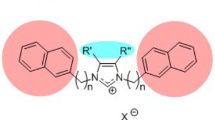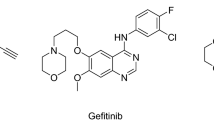Summary
Antitumor activity of the butyrophenone dihydrolenperone in non-small cell lung cancer was initially suggested byin vitro screening against tumor cells derived from fresh surgical samples using the human tumor colony-forming assay. We have completed a directed phase I trial in patients with lung cancer. Thirty-two patients with lung cancer have completed 25 courses of therapy at doses of 10 to 60 mg/square meter orally on a twice daily schedule. Twenty-three men and 9 women with a median age of 55 (range 24–69) were entered. Twenty-four were performance status 0 or 1 and 8 were 2. The maximum tolerated dose was 50 mg/square meter orally twice daily and the dose limiting toxicity was somnolence. Of the 32 patients, 18 developed symptomatic hypotension (grade 1 or 2). There was no significant hematologic, renal, or hepatic toxicity.In vitro drug testing using the MTT [3-(4,5-dimethylthiazol-2-yl)-2,5-diphenyl-tetrazolium bromide (thiazolyl blue)] assay confirmed 50% inhibition of non-small cell and small cell lung cancer cell line growth at 70–450 micromolar concentrations. Plasma dihydrolenperone levels were at least 75-fold less than levels at whichin vitro activity was observed. We conclude: 1) the maximum tolerated dose in our study is 50 mg/square meter orally twice daily, 2) the dose-limiting side effect of dihydrolenperone is somnolence, and 3) the concentrations of dihydrolenperone observed in plasma are significantly lower than those associated within vitro activity.
Similar content being viewed by others
References
Driscoll J: The preclinical new drug research program of the National Cancer Institute. Cancer Treatment Reports 68:63–76, 1984
Shoemaker RH, Wolpert-DeFilippes MK, Kern DH, Lieber MM, Makuch RW, Melnick NR, Miller WT, Salmon SE, Simon RM, Venditti JM, Von Hoff DD: Application of a human tumor colony-forming assay to new drug screening. Cancer Res 45:2145–2153, 1985
Alley MC, Scudiero DA, Monks A, Hursey ML, Czerwinski MJ, Fine DL, Abbott BJ, Mayo JG, Shoemaker RH, Boyd MR: Feasibility of drug screening with panels of human tumor cell lines using a microculture tetrazolium assay. Cancer Res 48:589–601, 1988
Scudiero DA, Shoemaker RH, Pauli KD, Monks A, Tierney S, Nofziger TH, Currens MJ, Seniff D, Boyd MR: Evaluation of a soluable tetrazolium/formazan assay for cell growth and drug sensitivity in culture using human and other tumor cell lines. Cancer Res 48:4827–4833, 1988
Skehan P, Storeng R, Scudiero D, Monks A, McMahon J, Vistica D, Warren JT, Bokesch H, Kenney S, Boyd MR: New colorimetric cytotoxicity assay for anticancer-drug screening. J Natl Cancer Inst 82:1107–1112, 1990
Rubenstein LV, Shoemaker RH, Pauli KD, Simon RM, Tosini S, Skehan P, Scudiero DA, Boyd MR: Comparison ofin vitro anticancer-drug-screening data generated with a tetrazolium assay versus a protein assay against a diverse panel of human tumor cell lines. J Natl Cancer Inst 82: 1113–1118, 1990
Monks A, Scudiero D, Skehan P, Shoemaker R, Pauli K, Vistica D, Hose C, Langley J, Cronise P, Vaigro-Wolff A, Gray-Goodrich M, Campbell H, Mayo J, Boyd M: Feasibility of a high-flux anticancer drug screen using a diverse panel of culture human tumor cell lines. J Natl Cancer Inst 83: 757–766, 1991
Clinical Brochure. Dihydrolenperone, NSC 343513. Division of Cancer Treatment, National Cancer Institute, 1986
Carney DN, Gazdar AF, Bepler G, Guccion JG, Marangos PJ, Moody TW, Zweig MH, Minna JD: Establishment and identification of small cell lung cancer cell lines having classic and variant features. Cancer Res 45:2913–2923, 1985
Gazdar AF, Carney DN, Nau MM, Minna JD: Characterization of variant subclasses of cell lines derived from small cell lung cancer having distinctive biochemical, morphological, and growth properties. Cancer Res 45:2924–2930, 1985
Stevenson H, Gazdar AF, Phelps R, Linnoila I, Ihde DC, Ghosh B, Walsh T, Woods EL, Oie H, O'Connor T, Makuch R, Kramer BS, Mulshine JL: Tumor cell lines establishedin vitro: An independent prognostic factor for survival in non-small-cell lung cancer. Ann Int Med 113: 764–770, 1990
Baldessarini RJ: Drugs and the treatment of psychiatric disorders. In: Gilman AG, Rall TW, Nies AS, Taylor P (eds) The Pharmacological Basis of Therapeutics. Maxwell Macmillan Pergamon Publishing Corporation, New York, 1990, pp 383–435
Wittes RT: Manual of Oncologic Therapeutics. J B Lippincott Company, Philadelphia, 1991, pp 445–448
Eagen RT, Fleming TR, Schoonover V: Evaluation of response criteria in advanced lung cancer. Cancer 44:1125–1128, 1979
Denizot F, Lang R: Rapid colorimetric assay for cell growth and survival. Modifications to the tetrazolium dye procedure giving improved sensitivity and reliability. J Immunol Methods 89:271–277, 1986
Carmichael J, DeGraff WG, Gazdar AF, Minna JD, Mitchell JB: Evaluation of a tetrazolium-based semiautomated colorimetric assay: Assessment of chemosensitivity testing. Cancer Res 47:936–942, 1987
Author information
Authors and Affiliations
Additional information
The opinions or assertions contained herein are the private views of the author and are not to be construed as official or as reflecting the views of the Department of the Navy or the Department of Defense.
Rights and permissions
About this article
Cite this article
Johnson, B.E., Parker, R., Tsai, C.M. et al. Phase I trial of dihydrolenperone in lung cancer patients: A novel compound within vitro activity against lung cancer. Invest New Drugs 11, 29–37 (1993). https://doi.org/10.1007/BF00873907
Issue Date:
DOI: https://doi.org/10.1007/BF00873907




